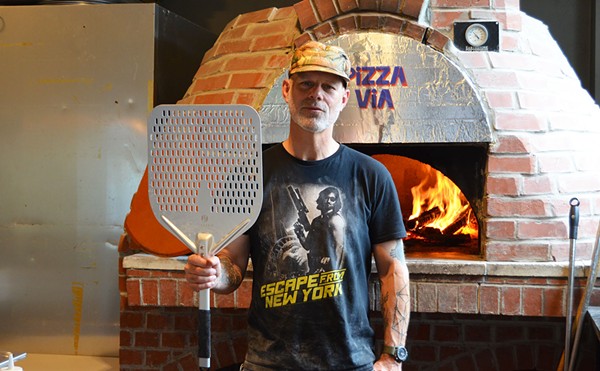I pose this query in response to a high-concept phenomenon in the culinary realm dubbed "pan-Asian cuisine." The term, which proposes an improbable link among the multifarious cuisines of the world's largest continent, is a misnomer. Unlike balls-to-the-wall fusion, which plunders equitably from every cuisine under the sun, upscale Asian chefs are more exclusive, purloining only what passes for "oriental" to the Western palate. The sweep typically commences with Japan and works its way south along the China seas before abruptly stopping in the vicinity of Thailand. The food then undergoes a Eurozation, where it receives a polish commensurate with its price tag. It isn't a cuisine so much as a shtick.
Pandering to the well-heeled American diner for whom the word "Asian" generally connotes ginger, soy sauce and eggrolls, pan-Asian cooking flaunts cultural idioms. It's pure theater, and in the right hands it can be entertaining. Of course, any restaurant seeking to define a new cuisine by appropriating the exotic should make restraint a high priority. Like a quail-egg slinger in Tokyo, whimsy without context can result in irony.
Irony is the enemy of dinner.
Shiitake's masterminds -- the Culinart Group's Del Pietro family, also of Portabella fame -- exhibit marginal sensitivity to this issue. Taking its name from the trendy Japanese fungus, the restaurant crafts a hip menu around what educated diners will instantly recognize as twists on oriental favorites and frames it in a tony, Claytonized package. Unlike those fusion-type bistros that allow the relentless pursuit of novelty to corrupt sound culinary practice, chef Thom Zoog puts out attractive food that is often pleasant and sometimes excellent. Yet a disparity between menu and environment suggests a misdirected focus. It's as though they've built a shrine to the cleverness of an idea and in doing so have unwittingly circumvented a crucial point: This kind of food ought to be fun.
And fun it could be, if it weren't foiled by an uptight, almost Orwellian climate. Somber charcoal walls, their sternness unmarred by ornament or artwork, accentuate the pallor of a smug, excessively Caucasian clientele. White linen is set with chopsticks in retentive little napkin bundles. Both times I visited, paranoia was everywhere; I felt as if I'd stumbled into an X-File when our server, evidently suspecting me of industrial espionage, insolently demanded to know why I'd been scribbling in a notebook. The poor busboy, who nervously catapulted himself between tables as though his very life were at stake, had the demeanor of a hunted animal. Even the room temperature was oppressively brisk. A milieu this tense is incompatible with the unapologetic lip-smacking, finger-sucking and napkin-soiling required by a plate of humble spareribs.
I ate mine with my fingers anyway, despite the fancy "honey-glazed seven-spice" description. They bore no apparent allegiance to shichimi, the peppery Japanese seven-spice seasoning, nor was a honey glaze detected, but as nuggets of tender barbecued meat in ample supply, they were gratifying in the good 'n' greasy manner of spareribs the world over.
Another favorite (despite a profusion of palmprints on the plate, which I suspect was not part of the intended presentation) was an appetizer of shrimp-and-lobster potstickers. Let's face it -- unless you've had a $300 kaiseki meal in Kyoto, most of the Asian foods you know and love are populist staples. The sturdy potsticker will naturally resist foolhardy attempts to turn it into something it's not. Despite some dangerously lofty aspirations, Zoog's version was first-rate. Crisped with precision and feather-light, these potstickers avoided the glutinous pitfalls that can daunt inferior specimens. Inside were fluffy morsels of perfectly cooked seafood, and the gingery sauce hit notes to harmonize agreeably with the filling. In short, they tasted exactly like potstickers.
This same spirit of authenticity empowered an order of sweet-and-spicy eggplant. More sweet than spicy, the eggplant strips were perfect junk food, fried just until flaccid and glossed with a tawdry glaze reminiscent of plum sauce. It was a satisfying, unpretentiously Chinese concoction.
Nowhere was the chef's poetic finesse more noteworthy than in the hot-and-sour duck soup, which I could contentedly slurp from a clumsy flat-bottomed spoon every day for a month. Crisp snap peas and meaty slices of the namesake mushroom serenely floated in a rich, woodsy broth that achieved a miraculous balance between tart and spicy. The only flaw was the duck meat, which, like the pork in Chinese takeout versions, was too sleepy to contribute to this otherwise invigorating treat.
Encouraged, I sanguinely tucked into a bowl of lobster pad thai. Rice noodles spiked with bean sprouts, carrot, basil and peanuts produced a result consistent with -- but somehow less eloquent than -- similar dishes found in the Loop. I deduced that lobster cannot be relied on to glorify street food, proving once again that this fickle crustacean is best deployed as a vehicle for clarifiedbutter. A few rubbery, listless claws added nothing but cost to this dish; I pined for the more complex and authentic additive of dried shrimp.
Postmodern interiors and aloof servers can do little but condescend to dishes like pad thai, but an entree of unusual tea-smoked swordfish proved worthy of its mannered environment. Unlike the red-curry mahi, which arrived on a mirthless bed of La Choy-ish vegetables and tasted predominately of salt, this dish was the very picture of refinement: two demure triangles of fish festooned with a swirl of peanutty noodles and julienned vegetables, combining texture and flavor with engaging subtlety. Though it coquettishly resisted the fork, the swordfish's inner self was succulent and receptive to the flirty advances of a tangy, esoteric sauce.
Other dishes for which I could discern only the most general Asian connotations met with varying success. A green salad with pickled-ginger vinaigrette arrived infested with a horde of fried lotus-root chips. I can't say these weren't delicious; a sack of those chips, a cooler of Sapporo tallboys and a couple of Jackie Chan videos could satisfy all my pan-Asian needs for a week, but, together with the savage shards of hot-tempered ginger, they reduced the frail mesclun fronds to a whimper.
The fried "fiery"calamari also occasioned whimpers, but these were mine; I had neglected to take the word "fiery" literally. Biting into a slice of well-camouflaged chile, I broke into a sweat, then broke into a smile; a cool, sweet mango sauce was an inspired accomplice to the impeccably crunchy squid.
With dessert came the piece de resistance of Shiitake's concept-worship: a chocolate-banana "spring roll." A slice of banana was wrapped in chocolate cake, encased in an egg-roll wrapper, then deep-fried and served with vanilla ice cream. I am no fan of cutesy sweets, and this one exemplified everything that is wrong with fusion cooking; too greasy and ponderous for a last course, it merely glorified style over content.
The dessertification of the egg roll was inevitable, but it makes about as much sense as a raspberry hamburger, from which observation I conclude that Shiitake's greatest culinary victories invariably favor gentle emulation over unbridled fantasy.
SHIITAKE RESTAURANT AND BAR, 7927 Forsyth Blvd., 725-4334. Hours: 5:30-10:30 p.m. Mon.-Thurs., 5:30-11 p.m. Fri.-Sat.; closed Sun. Entrees: $10.95-$16.50.
'





